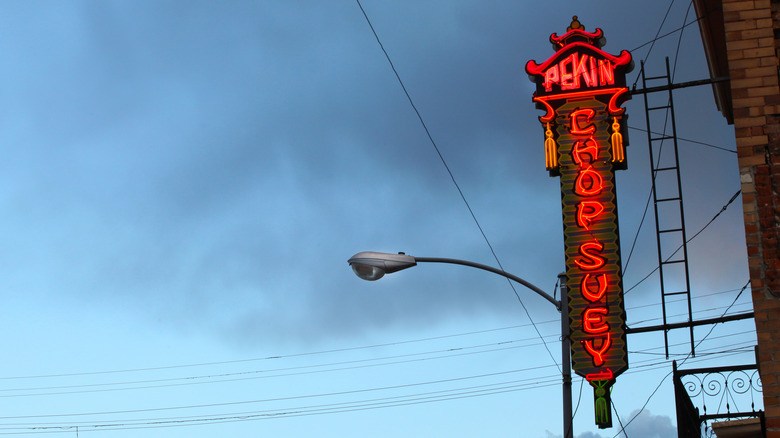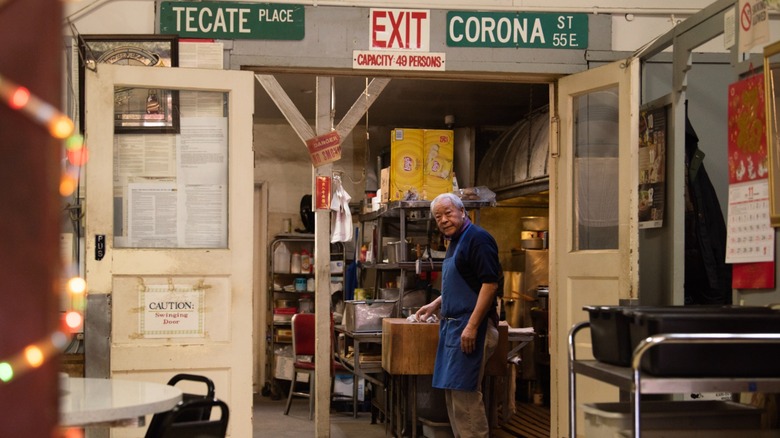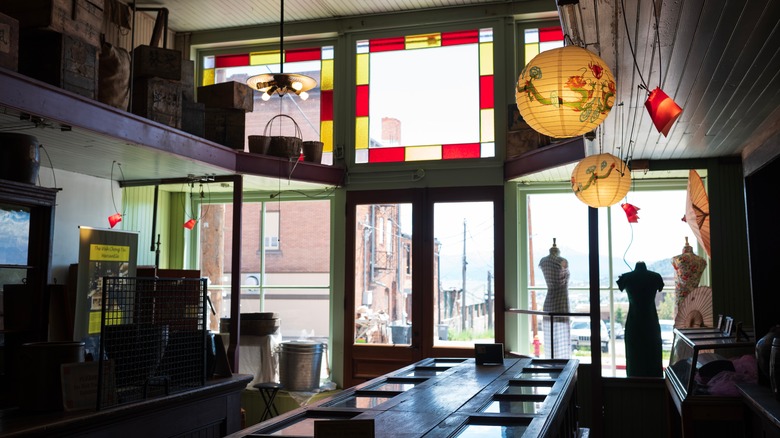How Montana Became Home To The Oldest Chinese Restaurant In The Country
When you think of iconic Chinatowns across North America, bastions of culture and cuisine, San Francisco might come to mind. New York City. Toronto, even. Unless you're especially well-educated on Chinese-American history or a resident of the Midwest, Butte, Montana almost certainly wasn't on your list. But since 1911, it's been home to the oldest continually operating Chinese restaurant in the United States — Pekin Noodle Parlor, the family-owned, incredibly well-preserved, known-for-their-delicious-chop suey Butte landmark.
It's hard to get an accurate number for the Chinese population in Montana at the time, since census data is known to have undercounted it. But according to author Rose Hum Lee, there were around 2,500 Chinese in Butte at the time Pekin first opened, making the mountain city one of the largest Chinatowns not on a coast (per "East Meets West"). The population settled a couple of decades when the gold rush of the 1860s, along with railroad jobs, brought many immigrants to the area seeking fortune or employment. When the Chinese Exclusion Act was passed in 1882, however, Chinese immigration and naturalization were blocked. Chinese residents of the United States, unable to become citizens, were relegated to low-paying jobs, eventually shrinking their populations nearly everywhere in America before the act was finally repealed in 1943.
But Hum Yow and Tam Kwong Yee, the first owners of the Pekin Noodle Parlor, stayed and made jobs for themselves through their entrepreneurship. More than a century later, the Tam family continues to serve the community. Be it regulars coming in every Friday for their tasty lo mein or tourists stepping into one of Pekin's orange booths to sit in 1920s chairs and eat one of the warm meals that have truly withstood the test of time.
A disputed title
In recent years, Pekin's status as the oldest U.S. Chinese restaurant has actually been questioned, with 2022 UC Davis research finding that Woodland's Chicago Cafe may, in fact, deserve the title instead. The cafe claims to have operated since 1903, which would place it years before Pekin Noodle Parlor, but efforts to confirm the assertion have proved inconclusive. Newspaper articles and ads have been able to show that Chicago Cafe was operating since at least 1910, but similarly, research shows that Pekin Noodle Parlor was serving customers as early as 1909, albeit in a different location than its current building.
According to the UC Davis paper, part of the reason why it's hard to nail down the exact opening date of these restaurants is because local directories in the early 1900s excluded Asian people and restaurants. For this reason, they were advertised largely by word-of-mouth. But whichever is true, it's indisputably impressive that both restaurants have lasted so long at all. While exact data varies, it's commonly agreed that keeping a restaurant running even past its fifth year is an impressive feat, let alone 110, as both of these establishments have done.
How Chinese restaurants give us a glimpse into the past
Even beyond the usual business woes, things weren't easy for these restaurateurs. Both opened while the Chinese Exclusion Act was in place, and both faced rampant xenophobia. People falsely claimed that MSG — a seasoning used in Chinese food — caused illness. Targeted attacks included a 1912 assault on Pekin co-owner Hum Yow and two of his waiters by five white miners and a 1910 stabbing of cook Hum Yum by a former police officer. Not only that, but restrictions were placed on restaurant owners or workers who were unable to become citizens, so the establishments had a lot to contend with if they wanted to keep their doors open.
But keep the doors open they did, serving as a place of employment and community for Chinese people in what was often a hostile environment — an experience that the UC Davis paper noted is common among immigrant groups. The research pointed to Jewish delis, Greek diners, Italian restaurants, and Irish pubs as a few examples of cultural stagwarts that have woven themselves deeply into American culture alongside Chinese restaurants. They're a reminder of just how much of our country's food and traditions today come from immigrants who worked hard to build the diverse communities — and restaurants — that make up our cities.


